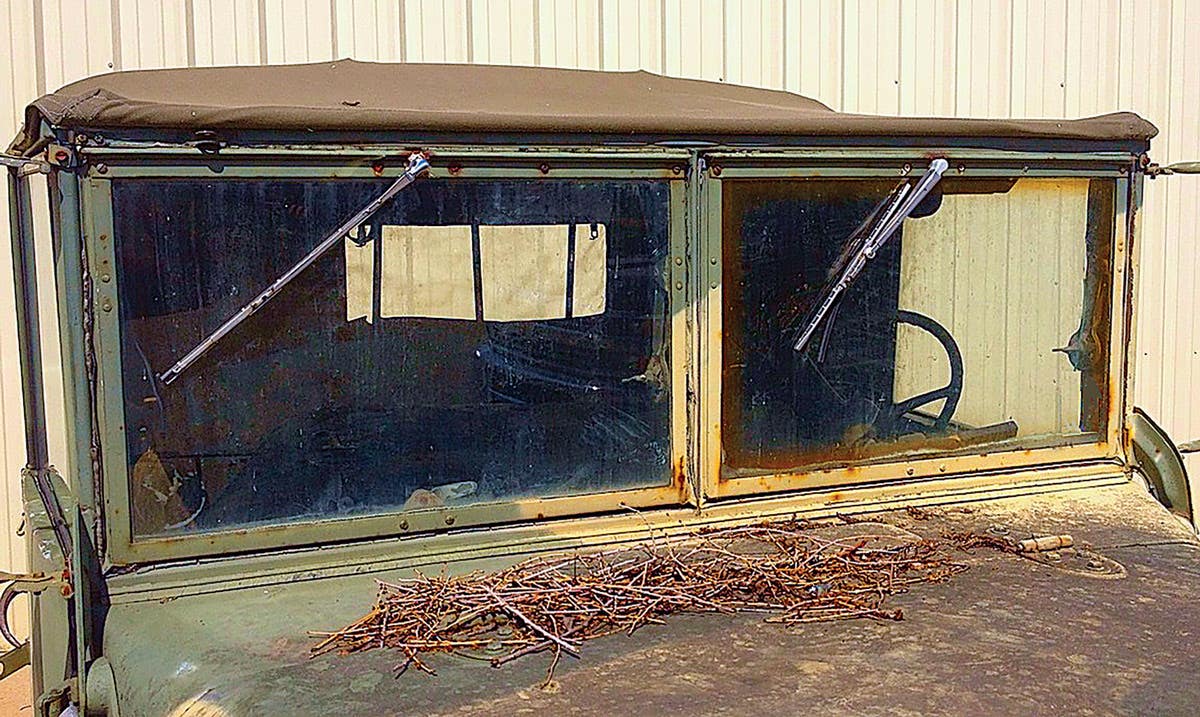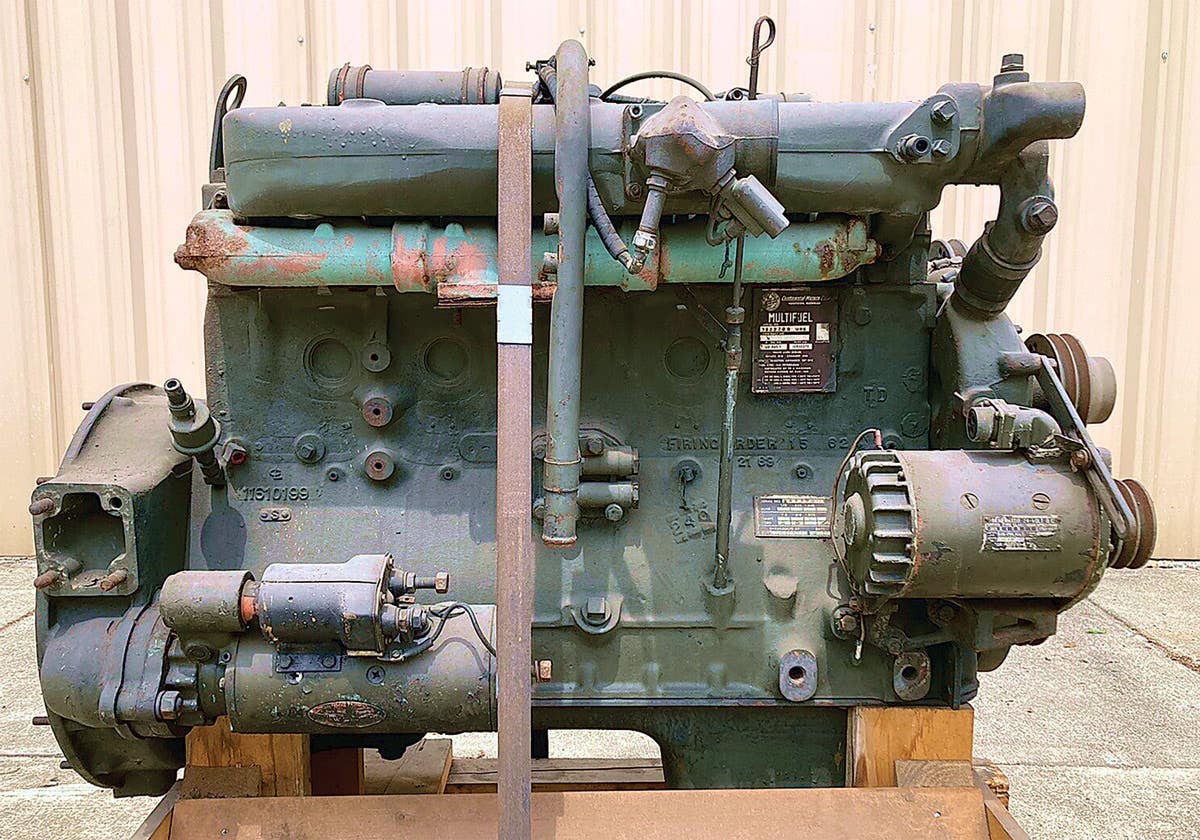Bright Ideas: Service and care of early M-Series lights
Tucked beneath the rear ends of many historic military vehicles, or protected by brush-guards in front, are those indestructible M-series tail/marker lamps. Here are some tips to keep’em shining.
Tucked beneath the rear ends of many historic military vehicles, or protected by brush-guards in front, are those practically indestructible M-series tail and marker lamps. If you own an early M-series vehicle, you probably possess at least four of these little aluminum lamps — or just two on the back of an M38 or M38A1 — and maybe another pair if your vehicle has its matching trailer.
If your vehicle is a very early M-series, the two lamps forward with clear oval lenses serve as parking lights and blackout markers. In the rear, one oval ruby doubles as service tail and stop light on the left, while its right-hand neighbor provides a blackout stop lamp on top, and the pair together furnish red blackout markers. On these vehicles, all but the left rear lamp have two light bulbs inside and perform only two functions, while the left rear lamp houses a third and larger bulb, which serves the service stop signal. On later or updated M-series vehicles, all the lamps have three bulbs, the front pair providing an additional function (with the larger bulb) of turn-signals — even if turn-signals were never installed — and furnishing two service stop and tail lights rearward. Since, in this case, the blackout stop function of the right rear lamp was lost, an additional separate bullet-shaped lamp, reminiscent of the WWII type fender-mounted blackout lamp, was added to the vehicle’s the right-rear area.
These early M-series lamps were manufactured by a seemingly endless roll of companies: Guide, Acco, Industrial Lamp Corporation, and Autolite are but a few. Although there are slight differences among the manufacturers in the style of the main oval glass — some have the stop lamp area optically ground to increase light intensity and some have a pebble-grained surface in the tail lamp area to diffuse the glow —- all of these lamps’ component parts will interchange. While the lens covers (doors) vary depending upon function, and there are a few relatively rare special function lenses, the basic difference in types are only between the two and three-bulb units. Even here, the lamp bodies themselves are the same.
Now we know what these lamps are all about and what they were designed to do. Chances are, unless you’re a dedicated restorer who, upon arrival of their new HMV treasure dismantles it down into its most infinitesimal parts to lovingly refurbish each bit, you haven’t paid much attention to the lamps as long as they were working. Maybe you did take a dab of rubbing compound and clear the lenses of excess OD oversprayed on them at some past motor-pool, but you had more important things to do, like installing your M37’s fording kit. Or, perhaps you were put off by these lamps’ formidable bullet-proof appearance, figuring anything built that well was pretty much trouble-free. Besides, they all worked, so if it ain’t broke, don’t try to fix it.
But, here’s a little scenario and maybe it’s familiar. It’s a beautiful afternoon and time to take your M-715 out for some exercise. Being a responsible safety-conscious person, you run a check of its service lights before mounting-up. Hmmm, no stop light and you did remember to turn on the dashboard switch. Undaunted by this, surely only minor, setback and prudently having picked up a few 24-volt bulbs at an HMV swap meet, you grab your nearest screwdriver and set about to rectify the situation.
Be warned that you might be spending this afternoon locked in combat with what is often the most obstinate little vehicle component you will ever encounter.
The first problem is there is so much paint lodged in the slots of the six cover (door) machine screws that your screwdriver can’t get a good grip. After it slips a few times, you turn the blade sideways and dig all the paint from the screw slots. Smart move, score one point. Now, while the screwdriver fits well, the screw refuses to budge. If this was your first-at-hand screwdriver, its blade may be too small or narrow so it still can’t get a good grip and may distort the screw slots, which renders them even more slippage-prone. This calls for a proper tool for a proper job. You return to battle armed with a good hefty screwdriver with a squared-off blade... the one you should have started with. Inserting this into a screw slot, you give it a hefty twist, whereupon you feel that sad little snap that indicates a twisted-off screw, and you tint the air blue with obscenities. Lose one point.
Well, there are five screws left to hold the cover on, so you haven’t disabled or badly disfigured your vehicle, and you’ll be more careful them. So, with more caution, you try to remove another. To your relief, that screw turns fairly easily and comes free intact. It doesn’t seem to want to come all the way out of the cover, and, after a few tries, you surmise (correctly) that there’s an internal retainer so the screw can’t drop out and possibly be lost.
Two down, four to go. The next screw also comes out fairly easily and you begin to feel this operation isn’t going to turn out badly. However, despite your newly-gained confidence, the next two screws suffer the same fate as the first, snapping off somewhere inside, while the last has such a messed-up head that even Snap-On’s finest can’t get a good grip on it. After a moment’s thought, you take a small pair of Vise-Grips, clamp them to the screw head and, after a couple of slips, manage to snap that one off. Well, at least the little SOBs are finally out! At first, you can’t get the lens cover loose, but you figure (rightly) that if you insert the blade of your screwdriver into various points around the cover’s perimeter and tap gently with a small hammer the cover will come off, revealing a view of the interior and maybe releasing a whiff of stale air trapped inside since 1952.
The innards are surprisingly complex, a jumble of wires, sockets, and metal fins. They’re also very corroded. All the ferrous metal is red with rust and the aluminum body has grown pale fur. Oh well, cleaning that mess will be a future project. Right now all you want to do is replace that burned-out bulb and salvage your day. Surmising correctly that the stop light bulb is the larger of the three, you reach in, grasping the bulb between thumb and forefinger, and twist. At this point, one of three things often happens. One: the glass globe twists off in your fingers leaving the corroded brass base still in the socket. Two: you twist the entire socket assembly loose from its rubber shock mountings within the lamp body and the bulb is still in the socket. Three: there is a crunching sound generally followed by pain and you spend a few minutes picking glass bits from your thumb and fingertips... and the bulb’s base is still in the socket. While this third occurrence is the least desirable, it might give you time to reflect that maybe that humble little lamp deserved more care and respect.
After many years of working on HMVs, I have found no common component so universally neglected, mistreated, treacherous, and curse-provoking as these early M-series lamps. If it’s any comfort — while you’re still picking glass from your digits — all of these incidents have happened to me. Yet, with proper care and service, these lamps can be some of the most dependable and trouble-free of your HMV’s parts. Often, this care must start with you, as few previous owners, including the military’s minions, performed it. Doing so it will add considerably to the safety and enjoyment of your HMV, not to mention simplicity next time you have a burned-out light bulb.
Although these lamps are, if undamaged, waterproof to at least two atmospheres, moisture trapped inside can corrode the innards. I would imagine that, if the lamps had been originally assembled in a totally dry atmosphere, this would not be the case but, even so, they were opened occasionally in their long career in climates less than high desert. While the lamp body and cover are of aluminum (the very last of these types are plastic, but they’re not what we’re dealing with) the six screws holding the lens cover in place are of relatively soft stainless steel. Over the years, the surrounding aluminum grabs the screw threads. Why an anti-seize compound or even plain grease was seldom used on these threads remains a mystery, but by the time these lamps have come into your possession it’s a moot point.
The most often successful way to remove the lens cover screws is to first clean all the old paint out of the slots. Use a good-quality screwdriver and make sure its blade is the proper size and fits the screw slot snugly. Exert a firm and steady pressure when turning the screw; don’t torque it suddenly or it may snap off (and probably will). Many times the screw will be reluctant at first but will gradually come free. There is a collar-type retainer on the screw inside the cover so don’t try to pull the screw all the way out. If you feel the screw start to turn but bind up again, try gently rocking it (tighten and loosen). You may find that it will give more and more until you can finally unscrew it all the way. Beware that you’re able to tell the difference between a screw that is actually turning and one that is merely having its head twisted off. The difference in feel is subtle but, after snapping a few, you’ll learn it. Penetrating oil or WD-40 seldom helps here, but you can try it.
If the screws are definitely frozen in place — and you can generally count on at least one — I’ve found that heating the lamp body tab of the frozen screw with a small pinpoint torch will expand the surrounding aluminum enough so that the screw will come out. This works so often that I usually forgo the initial struggle with the twist and pray method. A word of caution: aluminum heats quickly so don’t overdo the heat and roast the lamp’s interior parts. Usually, just sufficient heat to blister the paint on the tab is all it takes. If the screw starts to come out but binds again, you can re-heat the tab. Remember that aluminum transfers heat well so that more than the tab area will be hot.
At times you may find, though the screw is willing, its head has been too mangled by previous attacks for even your best screwdriver to get a bite. Here, a pair of small Vise-Grips may be used and the forementioned screw-removal procedure will work. If, at first, the Vise-Grips keep slipping off the screw’s round head, you may have to take a file and square-up the head a bit.
Sometimes, even after the best of care, the screw will snap off anyway. A consoling thought might be that it was probably fatigued from former battles. Many times there is enough shoulder remaining — after you’ve gotten the lens cover off — for a pair of needle-nose Vise-Grips to grab it and the heat treatment will still work. Remember that saving these screws is not so much a matter of mechanical aptitude as it is of using care and patience. It’s also essential to the saving of the entire lamp, as these screws are very difficult to drill out.
Anyway, one way or another, you’ve gotten the lens cover off. Though many times I’ve seen a lamp that looks horrible on the outside but has a pristine interior, generally it’s the opposite: a virgin-appearing exterior will reveal an inside as corroded as the Titanic. Here, you have a decision to make. While these lamps can be disassembled and cleaned, it’s a time-consuming job like most good restorations. Often, the simplest thing to do is to just get the lamp working. If you want to restore it, we’ll get to that later.
Many times, though corroded into their sockets, the bulbs can still be worked free. If you’re of the adventurous sort, go ahead, grab the bulb with your fingers and pull and twist until something happens. Me, I give the bulb a feel first. If its base moves at all in the socket you can generally push in gently, twist gently anti-clockwise and the bulb will come free. (They’re bayonet types.) If a bulb won’t move, there are special grabbers available to grip them safely. If you insist, go ahead with your fingers but keep your first-aid kit ready. Gloves are a possibility, but usually too clumsy. At best, all these methods usually leave you with the glass globe in hand but the bulb’s base in still in the socket.
What I usually do, if the bulb is obviously stuck, is to just break the bulb to begin with — a rap with the screwdriver will suffice (eye-protection is wise) -— then use a strong pair of needle-nose pliers or Vise-Grips to push and twist the base from the socket. Sometimes it’s necessary to crush the base within the socket until you can wiggle it free. Remember, the base must be pushed slightly into the socket before turning. WD-40 or equivalent sometimes helps. Heat here is a no-no because you will fry the internal wires and rubber shock mounts. Also remember that there are still likely bits of glass in there; and you don’t want to twist so hard that you tear the rubber-mounted socket loose from the lamp body. Once in a great while, even though you get the bulb’s base loose, you may find that the socket’s wire pigtail has welded itself to the bulb’s contact. If this happens, try not to pull the pigtail any farther out than absolutely necessary to get the needle-nose in and wiggle the contacts apart.
After getting the bulbs out, clean the sockets. There are little round wire brushes available for this task. Crocus cloth or sandpaper wrapped on a pencil or dowel will also work, but be sure to blow all the loose grit out afterward. The interior of the lamp can usually be cleaned without complete disassembly. If you want to take it all apart, remember to be careful not to snap off the tiny screws that secure the socket assembly to the lamp body. They, like the cover screws, are difficult to drill out, and then you’ll have to re-thread the holes. Even at this point the lamp could be rebuilt, but if you have several broken-off cover screws in the lamp body that your Vise-Grips can’t reach, the socket assembly is a mess of rust, and/or you can’t get the socket assembly screws out, maybe its time to shop for a replacement lamp, often found at government-surplus dealers or online. In the past I’ve paid anywhere from 25 cents to 10 bucks for a lamp, but they’re much more pricey these days. If possible, and for reasons already stated, always open a lamp to check its insides before buying it. Or, if shopping online, ask a seller to open it. Even a damaged lamp can usually be used for spare parts; and since the lamp bodies are all the same, you can build one to suit your purpose by exchanging interior parts and covers.
If you’ve disassembled and cleaned a lamp, you should paint the body interior flat white before reassembly. This will intensify the light output. Flat white works best, not gloss. Some brands of lamps were already painted white inside, but a touch-up won’t hurt. Before putting in the new bulbs (or clean old ones) spray the sockets with a non-corrosive moisture-displacing spray such as WD-40. Install the bulbs with the one larger bulb in the deepest-set socket, then spray the whole interior with the non-corrosive spray and wipe it off the glass globes. There is (or should be) a rubber 0-ring recessed in a groove inside the lens cover. Sometimes it will stick to the lamp body on removal, other times it’s missing or rotted and brittle, but without it the lamp isn’t waterproof. You may have a usable O-ring if you have a few spare lamps, or should be able to find a suitable replacement at an O-ring suppler either locally or online.
Make sure the 0-ring is set evenly in its groove and apply a light coat of the grease of your choice all around. Vaseline will also work. Don’t use gasket sealer; you want the O-ring to stay flexible. Make sure the cover screws have clean threads and apply a coating of grease or anti-seize compound. (If this had been done originally, you wouldn’t have had such a battle getting the lens cover off in the first place.) Spray the inside of the cover with the non-corrosive spray, wipe it off the lenses, and put the cover on the body. Evenly tighten all six cover screws so that the 0-ring seats all around. Be careful not to over-tighten and snap off the screws or you’re back to square-one. If your 0-ring was broken, brittle, or missing, and you can’t find a replacement, you can still make the lamp waterproof by applying a tin bead of silicone-sealer evenly around the lens cover groove, approximately the thickness of the 0-ring. Be sure that the silicone has thoroughly dried before you attach the cover to the lamp body.
If you’ve snapped off one or two of the cover screws and just want to fake it you can glue the screw heads back into their holes and nobody will be the wiser; just try to remember which are the glued heads when next you have to remove the lens cover. If you have to remove the entire lamp assembly, be warned that the two 3/8-inch bolts that mount the lamp from the rear are also prone to freezing in place. The rocking method and heat sometimes works to free them, but is more difficult because of the mounting plate itself and close proximity of the lamp’s wires.
If you have broken off one or both of these bolts, about your only option to replacing the lamp body is to carefully center-punch and drill down the middle of the bolt, whereupon you may be able to use an easy-out and heat to remove it. This is another area where you’ll have to decide how far you want to go to save a lamp versus replacing it. Again, use grease or anti-seize compound when installing these bolts but don’t overdo it as the bolt holes are blind and you can create enough hydraulic pressure when tightening to strip the body threads or crack the body. Also, the lamp must ground through these bolts, so you want them and the bracket to be clean. If you’re using new bolts, make sure they’re exactly the same length as the originals.
That should just about cover the most common problems you’re likely to encounter with these lamps. Hopefully, you’ve gained a bit of appreciation and respect for these bits of vintage HMV technology. And you may rest easier knowing that all it will take to fix a burned-out bulb next time will be a spare and a good screwdriver.
Looking for more HMV system info? Here are a few more articles for your reading enjoyment.







